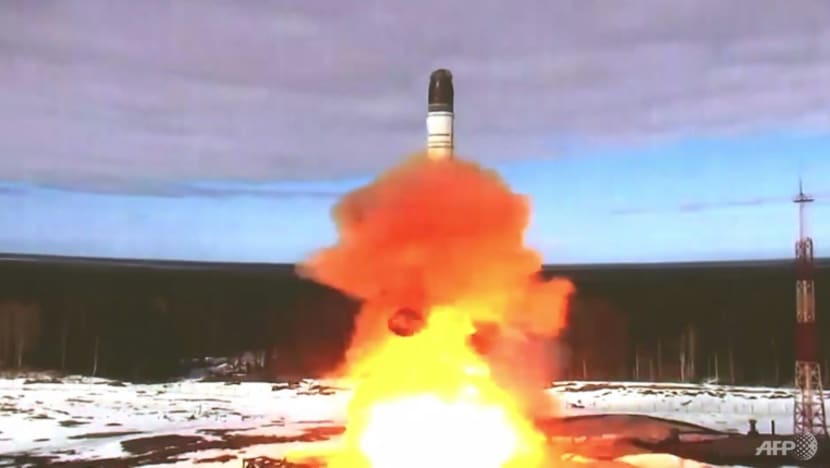Commentary: Nuclear war games are a risk NATO needs to take
Going ahead with operation Steadfast Noon in Western Europe during the Ukraine war shows Russian President Vladimir Putin that the West won't back down from his threat, says James Stavridis for Bloomberg Opinion.

The era of nuclear disarmament appears to be coming to an end, say experts. (Photo: Russian Defence Ministry/AFP/File/Handout)
NEW YORK: Last week, the North Atlantic Treaty Organization (NATO) started a round of exercises of its nuclear capabilities in Western Europe, centred in Belgium and the United Kingdom.
This comes at a particularly fraught moment in NATO-Russian relations, to say the least, given Russia President Vladimir Putin’s frequent rattling of the nuclear sabre over the past six months. Russia is “not bluffing” about tactical nukes, he insists.
While the NATO exercises were scheduled long ago — they are an annual part of a regular planning cycle — they come at an uncomfortable moment. What will the multinational drills seek to accomplish, and why did NATO decide to move ahead with them now?
SIMULATING NUCLEAR WAR
These are big, muscular events, and at least 14 of NATO’s 30 member nations (soon to be 32 with the welcome additions of Sweden and Finland) will participate.
Typically, the exercises would include dozens of fighter aircraft from various member states, large Airborne Early Warning Aircraft that are under NATO’s direct command, and sufficient refuelling aircraft to support the air armada. Long-range United States strategic bombers (the venerable but capable B-52s based in North Dakota) are participating as well.
The war games will be held more than 500 miles from the borders of the Russian Federation. Generally, they run 10 to 14 days, and it is unlikely that any news media will be allowed to observe.
Nicknamed Steadfast Noon, they almost certainly will not involve actual tactical nuclear weapons. Instead, the jets will carry “dummy loads,” meant to simulate using actual nuclear bombs.
There will be plenty of activity on the ground as well, simulating movement and maintenance of the weapons, and drills to safeguard them from both conventional military attack and terrorist activity.
I observed such exercises many times as NATO’s supreme allied commander a decade ago, and was always struck by the incredibly high level of attention to detail, the concomitant use of complex checklists, and the deep motivation of all the member-nations’ service members for even a simulated war.
ANNUAL TRAINING EVENTS AMID HEIGHTENED TENSIONS
Russia also holds annual nuclear forces exercises — known as Grom, Russian for “thunder” — which will receive a very high level of surveillance and study by NATO intelligence. This will probably take place later this fall, although the Russian military has yet to notify NATO of its intentions.
The US and NATO often “lean back” from conducting high-end military operations during moments of sensitivity. For example, when a US president is overseas for a summit involving a Russian leader, we might curtail some otherwise routine tactical military training so that no inadvertent incident could interfere with the meetings.
On the other hand, the US and its allies will not stop annual training events simply because of heightened tensions. This month, the US and South Korea are proceeding with high-end naval exercises off the Korean peninsula, despite the record-high number of ballistic missile launches North Korean leader Kim Jong Un has undertaken over recent months.
HOW WILL VLADIMIR PUTIN RESPOND?
The NATO secretary general in Brussels and the supreme allied commander at the military headquarters in Mons, Belgium, will be carefully assessing Putin’s possible responses to the NATO exercises. Among their concerns will be whether the Russian leader would use them as an excuse to conduct more aggressive nuclear drills than usual.
Could he position tactical nuclear weapons in the Russian enclave of Kaliningrad, which lies between NATO members Poland and Lithuania, or even among Russian forces on the “special military operation” in Ukraine?
There are no certainties in anything involving Vladimir Putin, but the calculus on the NATO side is that it is better to move forward with business as usual in the face of Russian aggression.
The other purpose of the exercises, of course, is to show the Russians NATO’s muscle. It is often said that deterrence is the combination of capability and credibility - the ability to accomplish something and a demonstrated will to actually do it. Steadfast Noon allows the NATO alliance to demonstrate both.
While the danger of an overreaction in Moscow is real, the greater danger would be allowing Russian threats, bluster and war crimes to intimidate the democratic alliance.

















